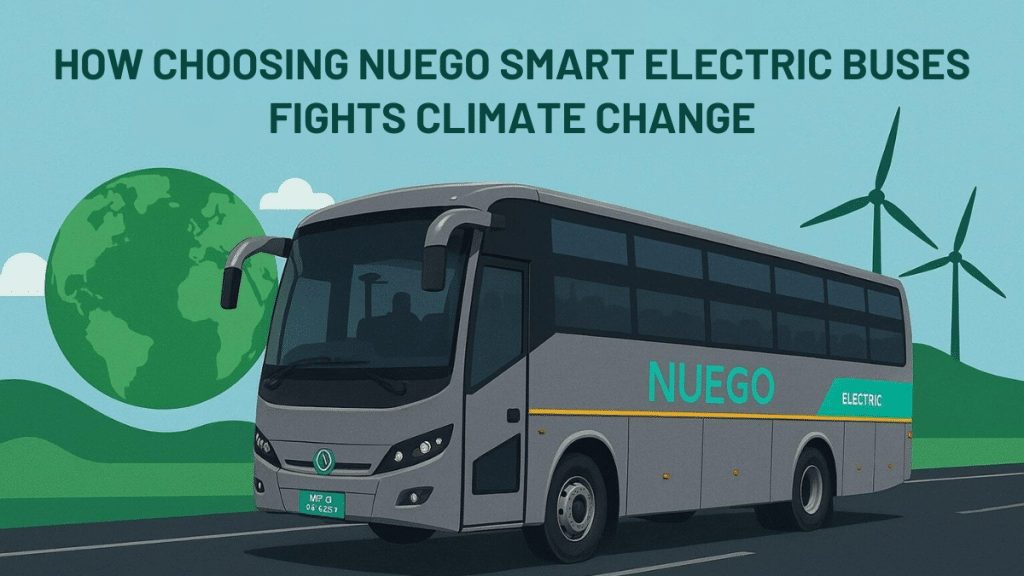Climate change is not a distant threat anymore. It’s happening around us, and transportation is one of the biggest contributors to rising emissions.
In India, intercity bus travel remains a primary choice for millions of people every day. While convenient, traditional diesel buses add significantly to air pollution and greenhouse gas levels.
Now, electric intercity buses are emerging as a reliable alternative. The message is simple: every ride counts when it comes to building a cleaner tomorrow.
Why Electric Buses Are More Than Just a Transport Upgrade
When people think about switching to an electric bus, they often assume it’s just about saving fuel or cutting costs. That’s not the whole picture. Electric buses reduce tailpipe emissions to zero, improve urban air quality, and lower noise levels in congested routes. For passengers, the ride is quieter, smoother, and less stressful. For cities, it’s a long-term strategy to cut down carbon footprints.
In fact, research shows that replacing just one diesel bus with an electric equivalent can reduce nearly 45 tons of CO₂ emissions annually. Imagine the impact when this change is multiplied across popular intercity routes like Delhi to Chandigarh or Chennai to Pondicherry.
Every Ride Counts: How Choosing NueGO Electric Buses Fights Climate Change
Let’s put this into perspective. The transport sector accounts for nearly 14% of global greenhouse gas emissions. Road transport is the largest slice of that pie. In India, buses remain the backbone of affordable travel, but their diesel dependence is unsustainable.
Choosing an electric bus for a single trip might seem like a small act, but collectively, it becomes transformational. For example, if 100 passengers choose an electric bus instead of diesel for the Delhi–Chandigarh route, they can save around 350 kilograms of CO₂ in one journey. Over a year, these numbers scale into thousands of tons of carbon prevented from entering the atmosphere.
What Makes Electric Buses Different?
Before discussing climate benefits further, it’s worth understanding the operational differences.
- Zero tailpipe emissions: Unlike diesel buses, electric buses don’t emit harmful gases like nitrogen oxides or particulate matter.
- Energy efficiency: Electric drivetrains convert over 80% of the energy into movement, while diesel engines hover around 35%.
- Lower noise: Reduced noise pollution makes intercity travel less taxing.
- Reduced dependency on fossil fuels: Cleaner energy grids mean electric buses are increasingly powered by renewable energy.
The ripple effect is clear: it’s not just about moving passengers, it’s about moving towards sustainability.
Case in Point: Delhi–Chandigarh Route
This corridor has become one of the most significant examples of intercity electric mobility in India. Passengers now have the option to choose fully electric buses, supported by GPS tracking, CCTV surveillance, and dedicated ladies’ seats. The emphasis is not only on sustainability but also on safety and comfort.
A trip that once carried the weight of diesel fumes and noise now delivers a smoother experience while helping reduce carbon intensity in North India’s travel landscape.
Extending the Vision Beyond Delhi and Chandigarh
It’s not just about one route. Electric buses are expanding rapidly to other cities. The idea is to make clean, affordable intercity travel accessible across India. For instance, passengers looking to book smart electric AC bus options in southern regions are also experiencing this shift. The increasing interest in the Chennai to Pondicherry bus route with electric fleets highlights how the trend is nationwide, not just in selected regions.
The Larger Impact on Climate Change
Transportation emissions affect more than just carbon levels. They also impact health, urban planning, and energy dependency. Choosing electric buses provides measurable advantages:
- Lower carbon emissions: Each electric bus can cut an estimated 1,000 tons of carbon dioxide over its operational life.
- Better air quality: Reduced soot and particulate emissions mean fewer respiratory illnesses in urban areas.
- Energy transition: Supporting electric mobility encourages renewable integration in the grid.
- Economic benefits: Lower running costs and reduced import bills for fossil fuels strengthen long-term national resilience.
In other words, every passenger who chooses electric intercity travel becomes a part of the climate solution.
FAQs on Electric Buses and Climate Change
How much carbon can a single electric bus save compared to a diesel one?
On average, one electric bus can save up to 45 tons of CO₂ per year, depending on the route and usage.
Are electric buses really reliable for long routes like Delhi to Chandigarh?
Yes, modern electric buses can travel up to 250 kilometers on a single charge with AC running, making them suitable for most intercity routes.
Do passengers pay more for electric buses?
Ticket prices remain competitive, often aligned with standard diesel bus fares, making sustainability accessible without a premium burden.
What about charging infrastructure in India?
Fast-charging stations are being developed along major highways, ensuring seamless long-distance connectivity.
Conclusion: Why Every Ride Counts
Switching from diesel to electric buses might look like a small choice, but collectively, it represents a major stride in the fight against climate change. Routes like Delhi to Chandigarh are proving that clean mobility is not just possible but practical. When more passengers make the switch, it creates a ripple effect, improved air quality, reduced carbon emissions, and healthier cities.
The bottom line is clear: every ride counts. Whether it’s a daily commute, a weekend getaway, or a business trip, choosing electric buses is more than a transport decision, it’s a contribution to the planet’s future.
